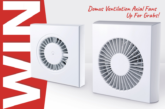
Short medium and long-term planning to keep your staff and customers happy
High temperatures tend to make us turn up the air conditioning, sending staff and customers scurrying to find cardigans and jumpers; offer round iced drinks, that raise our core temperatures as our bodies over compensate for the rapid cooling; and open all the windows, that often as not lets more heat in.
Environmentalists and meteorologists are emphatic that the recent high temperatures, are to become a regular and frequent feature in our lives.
This is part of a pattern of more extreme weather with hotter spells in summer and colder spells in winter too. Whether it’s commercial offices, retail outlets, warehouses, hospitals, care homes, hotels or universities, we need to learn to deal effectively with greater temperature fluctuations and start making our short, medium and long-term plans.
The challenge is continuing decarbonising to meet targets while providing day-to-day comfortable environments
Short-term
What can we do right now? If you are lucky enough to have air-conditioning, remember that even when it is hot outside, anything below 17 degrees is too cold for comfort and efficient working, so keep an eye on what cooling is achieving. Start collecting data on which offices, wards, sections, workstations or shop areas suffered most from direct heat from the sun. Look at shading options such as blinds, awnings, window films and even plants.
Bear in mind that all these options will be in demand when temperatures are high and may attract premium prices; awnings may also require planning permission. Look at how you can create through-drafts; if you can’t you may do better to keep windows shut.
Data is the key to problem solving; you need to know the nature and size of of the problem to work out appropriate budgets and scale of solutions. By the way, don’t rush out the iced drinks, better to offer cool, citrusy drinks or coconut water and slices of water melon, that will refresh and hydrate.
Medium-term
If you don’t have air conditioning, perhaps now is the time to look at the options available for heating, ventilating and air conditioning (HVAC), from single room air conditioner, fan and dehumidifier units, to a system to provide heating, cooling and air quality control throughout your building or chain of buildings.
Whatever the scale of your operation, start with sensors, as a low-cost route to gathering data on temperatures (even on days that are not extreme outside), humidity and maybe air quality, while you are at it.
HVAC obviously is best designed into a building when it is being built but retrofitting is viable and can be cost-effective in many situations.
Whatever the solution you are favouring, you need to be able to monitor and control what is going on, you might be surprised at how often both heating and cooling are running at the same time or while windows are open. Unoccupied rooms frequently have lighting heating/cooling running for periods during the day but also at night and weekends when offices are shut.
Remember it is not just temperature that makes us feel hot; humidity above 50% makes us feel hotter and, by the way, boosts dust mites, allergens, and bacterial growth. Equally, low humidity can make our eyes, skin and airways feel too dry and becomes uncomfortable.
Some office equipment, such as copiers, or refrigerated displays in shops or laundry machines emit heat when operating, so thought might be given to optimising the time and duration of operating. Proper monitoring will ensure that you continue to minimise your carbon footprint and energy bills.
You might also wish to look at flexible working hours to favour cooler hours. Maybe hot-desking could also be cool-desking, as workers move to warmer or cooler areas of the building to suit their needs.
Longer-term
Temperatures up around the 40-degree mark place stresses on bodies and buildings that are not designed to cope with them, especially in the UK, which historically has a temperate climate of cool, wet winters and warm, wet summers.
Higher and lower temperatures, stronger winds, higher tides, lower water tables, rising river levels and other changes to the environment will place stress on the built-environment, working conditions and people. We should be looking to the future and considering what we can do to take advantage of the opportunities and mitigate the stresses.
More sunshine and wind may make the case for adding solar panels and wind turbines more attractive. Maybe we should be capturing rain water and planting roofs, balconies and ground areas.
So as temperatures soar once again, the responsibility for health and safety falls back onto employers, who have a duty of care for staff and customers.
Building management systems (BMS) and building technologies go beyond energy efficiency and can greatly improve our well-being.
We should be looking for technology that will make a real contribution to making our buildings smarter and more intuitive. Accurate sensor data is essential to maintaining the balance between indoor air quality and energy efficiency: temperature, humidity, carbon dioxide (CO2), Volatile Organic Compounds (VOCs) and fine particulate matter (PM2.5) provide a good indication of ventilation efficiency and viral transmission risks.
Exciting developments such as electrochromic glass that automatically adjusts tinting as the sun moves round; batteries to store energy produced by renewables and improved BMS will all have an increasing role to play.
By Mark Beaumont, Head of Strategic Accounts – UK Building Products Siemens Smart Infrastructure
Find out more here








